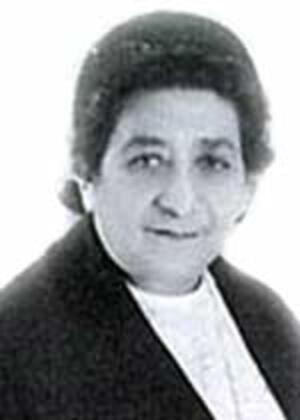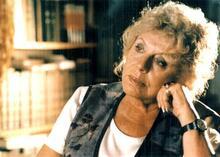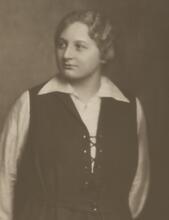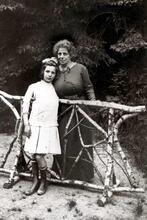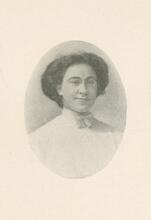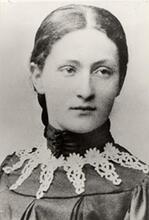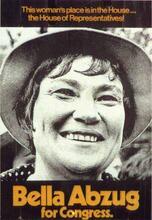Tova Sanhadray-Goldreich
Tova Sanhadray-Goldreich was born in Tarnopol in eastern Galicia. She became involved with local chapters of religious Zionist movements in her twenties, while teaching Hebrew and preparing herself and others to make aliyah. She emigrated to Palestine in 1934 by herself, taking temporary jobs while remaining active in the religious Zionist movement. She was among the founders of the women’s branch of Ha-Po’el ha-Mizrachi, a trade union in the movement, which aided women workers with childcare and finding work and housing. She oversaw the 1960 merger of three organizations into the Movement for National Religious Women, which became Emunah. In 1959 she was elected to the Knesset and served for four terms, where she was particularly focused on legislation relating to families.
Tova Sanhadray, chairwoman of the Emunah organization and the first woman member of the Lit. "assembly." The 120-member parliament of the State of Israel.Knesset to represent the National Religious Party, is regarded as a pathbreaker, since she began her public activity in Israel at a time when the participation of religious women in public life was not yet considered acceptable. During the years of her activity, she made religious women and the services provided them her priority and worked vigorously for progress in these areas.
Early Life and Zionist Activity
Tova Diamand was born on September 23, 1906, in Tarnopol in eastern Galicia (today Ukraine) to Shlomo Diamand, a wood merchant, and Esther (née Glickman). The Diamand family was strongly Zionist and Sanhadray’s parents served as leaders in the Ha-Noar ve-he-Halutz movement in the town.
Tova Diamand attended the public Polish primary school and afterwards the Hebrew high school in Tarnopol, graduating with distinction. She learned Hebrew as a child, even winning prizes for essays that appeared in Hebrew newspapers. She began her public activity in her twenties, while she was still attending the Tarbut teachers’ seminary. She was elected as a delegate to the Mizrachi and Ha-Po’el ha-Mizrachi (see: Religious Zionist Movements in Palestine) conferences in Poland, and in 1938 her name appeared in the community books as one of the leaders of He-Halutz ha-Mizrachi. She was among the founders of the Benot Mizrachi and the He-Halutz ha-Mizrachi movements and was elected to the latter’s central committee in Poland. In 1931 she was sent as a delegate to the convention of He-Halutz ha-Mizrachi held in Lvov. Parallel to her public activity, Tova Diamand taught Hebrew, joined the religious pioneer movement Torah va-Avodah, and served in a leadership role in the movement in eastern Galicia. Before immigrating to The Land of IsraelErez Israel in 1934 she coordinated groups of agricultural trainees and of young people preparing for Lit. "ascent." A "calling up" to the Torah during its reading in the synagogue.aliyah.
Supporting Women Workers and Religious Women in Palestine
Emigrating to Erez Israel in 1934 by herself, Tova Diamand took temporary jobs to support herself and lived in a tiny room in Tel Aviv. Her arrival in Erez Israel at the same time as a large group of women activists from the He-Halutz ha-Mizrachi movement accelerated Ha-Po’el ha-Mizrachi discussions regarding the establishment of an organization of Ha-Po’el ha-Mizrachi women workers in Palestine, to aid them in their absorption, find them lodgings and work, and establish child care facilities. Tova Diamand was among the founders of Ha-Po’el ha-Mizrachi’s women workers’ organization, beginning with its first conference in 1935. In 1936 she was elected as the secretary-general of the movement, which she headed for 50 years. In this role, she was, inter alia, responsible for finding employment for religious immigrant women workers and she also established day-care centers, kindergartens, and baby homes.
In 1936 Tova Diamand married the Russian-born Rabbi Yisrael Sanhadray (1910–1966), the secretary of the Ezras Torah organization, a member of the Central Committee of the National Religious Party and a public activist. After his death she married Rabbi Kalman Goldreich.
In 1948, Tova Sanhadray went to the United States and Canada as an emissary of the movement. In the United States she established a sister organization for the women of Ha-Po’el ha-Mizrachi. Sanhadray was among those who initiated the merger between the Mizrachi Women Workers’ Organization, Mo’ezet Ha-Po’alot, and the Mizrachi Women (Omen). When the merger agreement was signed in 1960, she was appointed coordinator of the united movement, which was called the Movement for National Religious Women (Tnuat ha-Ishah ha-Datit Le’umit), later known as Emunah. Sanhadray later served as vice president of World Emunah.
A Career of Public Service: Knesset and Beyond
In the first Knesset elections, after the ultra-Orthodox made their participation in the joint religious-haredi-Religious Front list conditional upon the exclusion of women from the list, Sanhadray initiated and led a list of religious women, the Religious Woman Workers (Ha-Poelet ha-Datit), but the list fell several hundred votes short of the threshold, and Sanhadray was not elected. Not given a realistic place on the Ha-Po’el ha-Mizrachi list in the elections of the second, third, and fourth Knessets, only in 1959 was she elected to the Knesset, where she served for four terms. In 1963 Sanhadray was appointed deputy speaker of the fifth Knesset, a position in which she served for approximately a decade during the fifth, sixth, and seventh Knessets. During her time in office Sanhadray was a member of the Labor and Public Works Committee, served as the chairwoman of the Committee for Public Petitions, and as chairwoman of the Subcommittee for the Blind.
As a representative of the religious factions Sanhadray worked in the Knesset to influence legislation related to the family, though her political leanings were neither entirely liberal nor entirely conservative. She fought against the granting of legal rights to common-law spouses and vigorously opposed what was known as “the social clause” in the amendment to the abortion law, which permitted abortions on socio-economic grounds. In contrast, Sanhadray also drafted bills that could be termed feminist, such as an anti-pornography bill drawn up with other women Knesset members, including Shulamit Aloni, a 1961 proposal to establish equal salaries for men and women, and a bill concerning women’s employment. On the topic of Israel’s terrirory Sanhadray was hawkish: she opposed territorial concessions and supported the settlement movement in Judea and Samaria.
In addition to her parliamentary work, Sanhadray chaired the Israel Council for the World Organization of Social Workers from 1960 to 1962. She was a member of the Institute for International Research on the Heritage of the Jewish Family, the Parliamentary Association, the executive of the World Jewish Congress, and other bodies. She also helped found the National Service Association in 1971, serving as its president for fifteen years. However, her major extraparliamentary activity was in Emunah. As part of her role in the organization, she helped establish a religious educational infrastructure in Israel, ranging from day-care centers for toddlers to high schools and vocational schools. She also established home discussion groups and a financial infrastructure based on fundraising.
In 1977, after fourteen years as a member of Knesset, Sanhadray announced that she would not run in the elections in order to allow other members of Emunah the opportunity to represent the party in the Knesset. However, she continued her public activity until her health declined, compelling her to use a wheelchair and enter an old-age home. Tova Sanhadray died in 1993 at the age of 87.
Maizlish, Shaul, editor. I Have Chosen Faith [Emunah]: A Character Sketch of Tova Sanhadray-Goldreich (Hebrew). Tel Aviv: 1996.
Tidhar, David. Entsiklopedyah le-ḥalutse ha-yishuv u-vonaṿ: demuyot u-temuot (Encyclopedia of Pioneers and Builders of the Yishuv). Tel Aviv: Sifriyot rishonim, 1947-1971.

